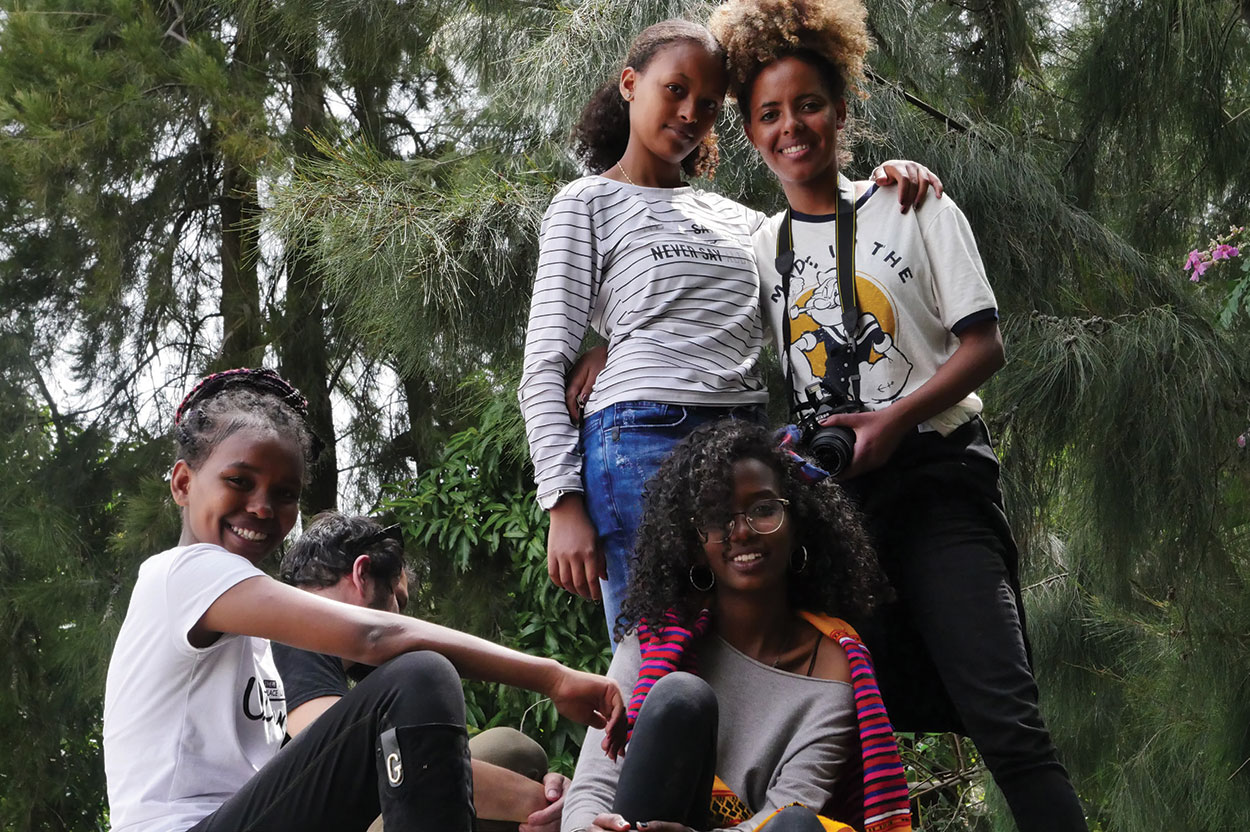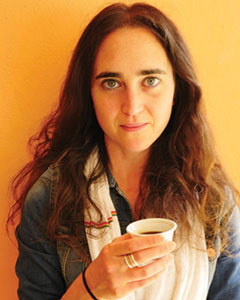Above: R.B. Kitaj. Eclipse of God (After the Uccello Panel Called Breaking Down the Jew's Door), 1997-2000. Oil and charcoal on canvas, 35 15/16 in. x 47 15/16 in. Purchase: Oscar and Regina Gruss Memorial and S. H. and Helen R. Scheuer Family Foundation Funds, 2000-71. Photo by Richard Goodbody, Inc. Photo Credit: The Jewish Museum, New York / Art Resource, NY. © 2020 R.B. Kitaj Estate
Yerus: No matter what we do, this is what we get. “These Ethiopians, these barbarians, they infiltrate Israel.” Take police racism, for instance, they treat us like invaders, criminals, even though this is our home. And the strangest thing is, who knows the feeling of exclusion better than the Jewish people? We weren’t accepted in Europe because we were Jewish, and now you don’t accept us because we’re Black?! You were discriminated and now you discriminate us. You’re not accepting yourself! We are PART of you, can’t you SEE?
Yerus was born on a plane that flew from Addis Ababa to Ben Gurion Airport. For her family, her birth symbolized an epic reunion after centuries apart, between Beta Yisrael—the Jewish Ethiopian Diaspora—and the entire Jewish world. Her father named her Yerus there and then: “Like a drop returning to the ocean,” he said, quoting the traditional Ethiopian proverb, “we will return to Yerusalem.”
A dozen years later, on the grass outside her caravan, Yerus is faced with an ocean of hatred, the tears on her cheeks are oceans of pain. She opens her mouth, her classmates ask, “How come you know Hebrew so well?” Her A+ in math upsets her teacher, “How come she got it right and you Israelis didn’t?!” Every afternoon, kids from the B’nai Akivah Jewish Orthodox youth group come around the block and yell at her that she’s not Jewish.

Alamnesh (pseudonym), participant-researcher, recording her first single in Tel Aviv, Israel. Photo by Rafi Shargai.
In late June 2019, an off-duty policeman entered her neighborhood and spotted a group of teenagers. Yerus had a feeling about how this was going to end. First, he’d pick up a conversation. Then, he’d pick up a gun. The death of eighteen-year-old Solomon Takka that night from that bullet sent the entire Ethiopian Israeli community to the streets, and in the following weeks Yerus joined many thousands in protest. Their signs said: “Police Murders Beta Yisrael,” “Black = Second-Class Citizen,” “My Blood Is Good Only for Warfare.”
These signs conjure heated demonstrations that occurred before Yerus’s lifetime: back in 1985, when Beta Yisrael finally set foot in Yerusalem, the core symbol of their Jewish faith. These Jews walked by foot in thousands, from the hilltops of Gondar, Ethiopia, through the Sudanese desert, and into the State of Israel, to make their faith come true. Only at the border, the price of the ticket became clear: To become Israeli citizens, they must convert to the halakhic Jewish model and leave their unique Jewish tradition—one that is closer to Second Temple Judaism—at the door. Still sore from the exodus, thousands marched to the state parliament in Jerusalem. “We are Jews Like You!” their signs said, “Like you!” “Why should we convert?! Color won’t come off in the mikveh!” “Calm down,” rabbinate officials came out to lighten the spirits, “this is not racism here; we’re doing you a favor, building you a bridge over 2,000 years of Jewish development.”

Alamnesh, Serkalem, Workitu, and Yerus (pseudonyms) participant-researchers, collecting data in Gondar, Ethiopia. Photo by Rafi Shargai.
Beta Yisrael, the Jewish tradition of Ethiopia, is murdered in Israel. In Kiryat Hayim in 2019, the police shot the gun; in Jerusalem in 1982, the rabbinate did. These two scenarios delineate the tragic slope of Ethiopian Judaism in Israel. While Yerus’s father dreamt of Jerusalem of Gold, Yerus grew up with the reality of Blackness: police brutality, fear of “infiltrators,” institutional discrimination, religious delegitimization.
For Yerus, this makes no sense. How could there be a divide between her and other Jews?! “We are part of you, can’t you SEE?!” she asks me, as if our Jewish belonging should be no less evident than the varying shades of our skin. In Ethiopia, Yerus wasn’t Black, but Jewish. Her kin were named Falasha, “wanderers,” a degrading term assigned to Jews as a religious minority who were forbidden by law to inherit land. In Israel, everybody calls them “Ethiopians,” always distinct from other Israelis. While Yerus is accustomed to being somebody’s Other, she can’t understand how those who know in flesh the feeling of exclusion, exclude her, who’s one of them.
Yerus’s exclusion from Israeli society is not foreign to me. I’ve been teaching and learning with Ethiopian Israeli teenagers since I was eighteen. In recent years, Yerus and I, parents and neighbors, set to explore what makes a Black Jew in Israel into a seemingly contradictory identity. We learn that the civic and religious identities of Ethiopian Israelis are in conflict: as Jews, they are part of the religious majority, as Blacks, they are forever foreign. Throughout the 2019 demonstrations, the struggle ofzEthiopian Jews against Israeli nationhood became clear beyond doubt. “Go back to Africa,” angry drivers yelled at the protestors, “We’ll win the war without your blood.” These expressions of hatred tell a greater story about the Jewishness we both share as Israelis: something had to happen for Yerus to become Black in the land of the Jews.
What is Jewishness—religion, race, civilization? is an ever-open question. Yerus’s hurt and confusion attests to a change of its function in Israel: it is used to discriminate between Jews of Difference—in tradition, values, and pigments. But like Schrödinger’s cat, the essence of Jewishness is responsive to how we perceive it, and what we’re using it for. The State of Israel uses Jewishness as a weapon in a war: not only against the Palestinian people, but against Jewish diversity.
In the context of Israeli statecraft, Jewishness is recruited for creating social cohesion, but this recruitment is detrimental to the bounty and diversity that characterize Jewishness most of all. In diasporic settings, striving for cohesion was a way of creating Jewish continuity across space. In a Jewish state, however, this same attempt brings about discrimination and hatred: Ethiopian Israelis who look different and observed a different Jewish tradition for centuries remain outsiders to Israeli society.
But in and of itself, Jewishness offers diversity a stable apparatus, and a long rope: Why else would we have Talmud pages full of contradicting views, or joke about two Jews having three opinions, or founding two synagogues in a deserted island so there’ll be one they don’t attend?
A core idea in Kabbalah is the “Union of Opposites,” which delinks the idea of unity from that of uniformity. In Israel, the only unity possible is that which cherishes the divergent pathways that brought us all there. The hatred Yerus feels every day results from a refusal to unite across difference. Let Yerus and her community remind us that Jewishness is a diversity, before all.

Photo by by Rafi Shargai
MARVA SHALEV MAROM is a PhD student at Stanford Graduate School of Education in the Concentration in Education and Jewish Studies (EdJS). Her dissertation explores the intersection of Jewishness and Blackness in Israel from the perspective of Ethiopian Israeli girls, building on community-based modes of inquiry